Column One: Texas once had 1,000 dance halls. Now there’s a rush to save those that remain

Built more than a hundred years ago by Czech, German, Polish and Swiss farmers, the halls are disappearing in Texas.
- Share via
As she watched couples in cowboy boots whirl across the dance hall her ancestors built in 1879 — the place where she played as a child, met her husband, married off her son and taught her grandchildren to two-step — Jo Nell Haas despaired.
Twin Sisters Dance Hall used to draw people by the hundreds. In the early days, families came from surrounding farms on horseback to waltz Saturday night away under kerosene lamps. Children played in the nursery out back heated by wood stoves. Elders supervised young dancers from the “buzzard’s nest,” a platform near the entrance, ensuring they didn’t get too familiar.
Lyndon B. Johnson is believed to have danced at Twin Sisters growing up. Rock and Roll Hall of Famer and Grammy winner Bob Wills and His Texas Playboys pioneered western swing from the narrow stage.
But on a recent Saturday, only about 20 people had arrived in time for the first dance of the night.
“This is not hardly anybody,” Haas, 61, said as she staffed the door, hoping to sell a few more tickets. The sparse crowd was greeted by a sign advertising the night’s country band, Caliche Crossroads, and their motto: “Keep Texas Two-Steppin’.”
In 140 years, Twin Sisters has never stopped hosting dances. But it’s come close. And Haas fears it could go the way of hundreds of other dance halls, Texas traditions that survived the 19th and 20th centuries only to shutter in the 21st.
The German immigrants who built it by hand named the hall Twin Sisters, Tanzsaal der Zwillinsschwestern, after a pair of surrounding hills. The club created to run it was chartered with one condition: monthly dances. Men — and later women — paid a nominal fee to join and bring their families. Even during the World Wars and Vietnam, when other halls went quiet, the dancing never stopped at Twin Sisters.
Like Twin Sisters, dance halls across the state were built by immigrants: Czech, Polish and Swiss, as well as Mexicans, who created conjunto music, an accordion-driven polka hybrid. Many towns once supported multiple halls, and in some parts of Texas it was common to hear more German than English.
But over time crowds dwindled as descendants died or moved away. Bands became expensive. In recent years, the cedar shingle roof at Twin Sisters started to leak. The pine plank floor threatened to buckle.
“This hall almost died,” Haas said.
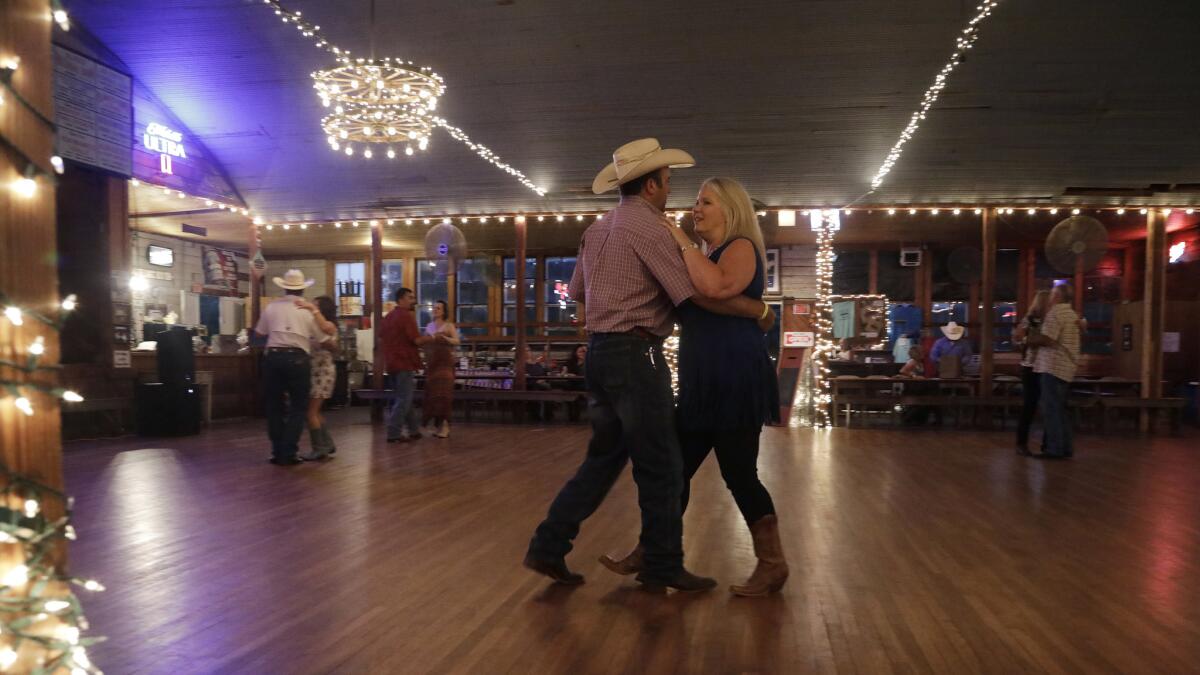
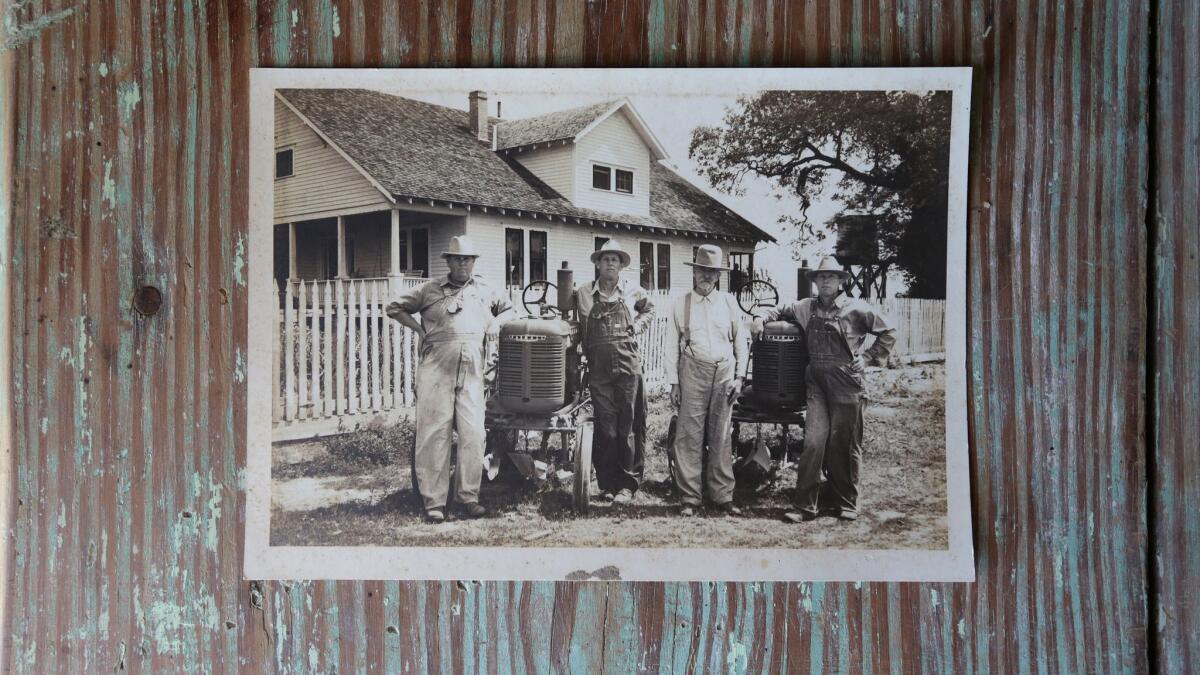
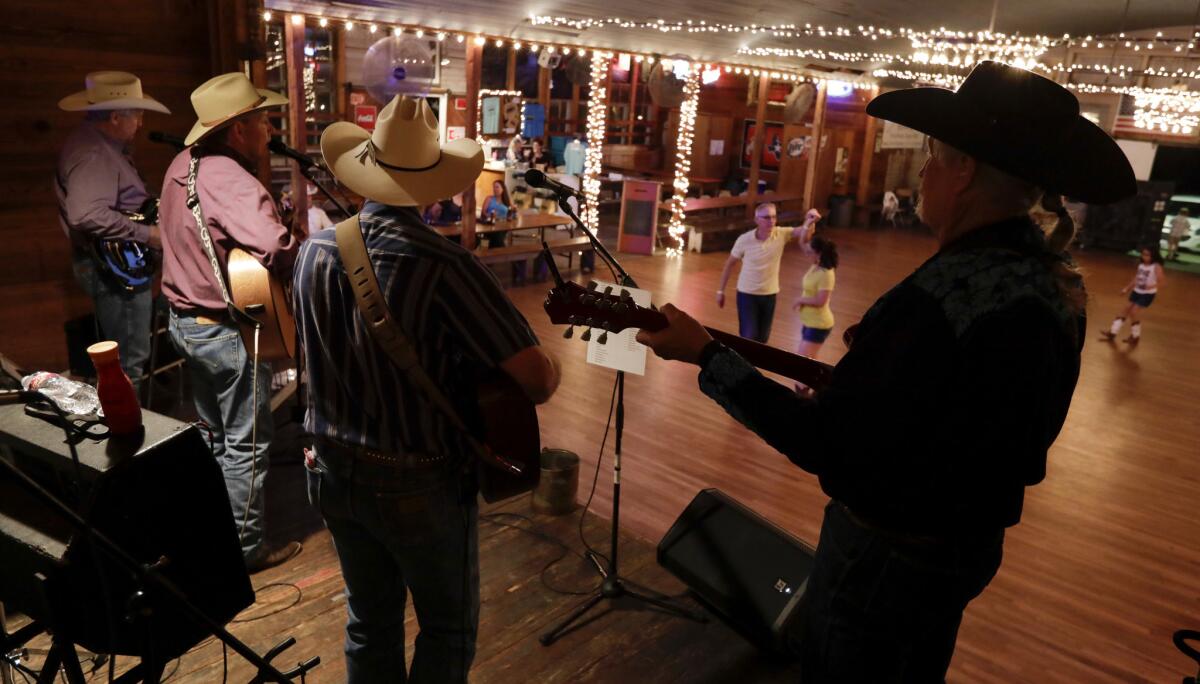
The former day-care director had learned to dance there, like many locals, “at her grandfather’s feet,” and decided she had to save the hall. Five years ago, she successfully ran as the first female president of the hall club, and contacted Austin-based Texas Dance Hall Preservation Inc. for advice.
Deb Fleming, the nonprofit’s president, showed her how to apply for nonprofit status and private grants that saved the roof. Haas learned to find more affordable bands and to alternate dances with nearby halls to ensure a crowd. She enlisted her husband to tend bar, her two daughters’ families to clean the grounds and to raise funds.
Still, Haas has kept calling the nonprofit for tips.
“There was many nights I called them in the middle of a dance and said, ‘I don’t know what to do — it’s horrible,’” Haas said. “It’s scary, our country’s losing so much history.”
Spring is dance hall season in central Texas’ Hill Country, a time for festivals, weddings and fundraisers before the summer heat descends. The state once filled about 1,000 dance halls. Now there are about 400 the Austin nonprofit is trying to save.
Some halls are abandoned, others overgrown with weeds. Some have simply fallen apart, like Double Bayou Hall east of Houston (part of the blues Chitlin’ Circuit) or Helvetia Hall north of Austin, which Fleming said, “melted into the ground.”
In an effort to save halls, Austin singer Ray Benson and his band, Asleep at the Wheel, stage monthly tours with stops at Twin Sisters and a handful of others. Erik McCowan, a dance hall aficionado, hosts day-long “Dance Hall Road Trip” tours and last year released “Dance Hall Days,” a documentary about the halls.
On Saturday, his tour stopped at what German settlers dubbed Katzenquelle, or Wildcat Spring. The local Turn Verein Hall — which doubled as a gym — closed in the 1940s, but the community renovated another nearby venue, the Cat Spring Agricultural Society Hall.
James Herring recently walked through the 12-sided building, explaining how he helped restore the 14-foot pine beams supporting the massive cupola built in 1902.
Herring, 81, director of the agricultural society, grew up speaking German until he started school. A hand-painted wooden sign warns visitors in German, “The wearing of the hat & the spurs, the smoking & the chewing is in this hall forbidden.”
“The ladies had these big hoop dresses and the spurs would catch on them,” said Herbert Kollatschny, 82, who grew up dancing at the hall.
“And the hat — they used to carry six-shooters under them,” Herring added.
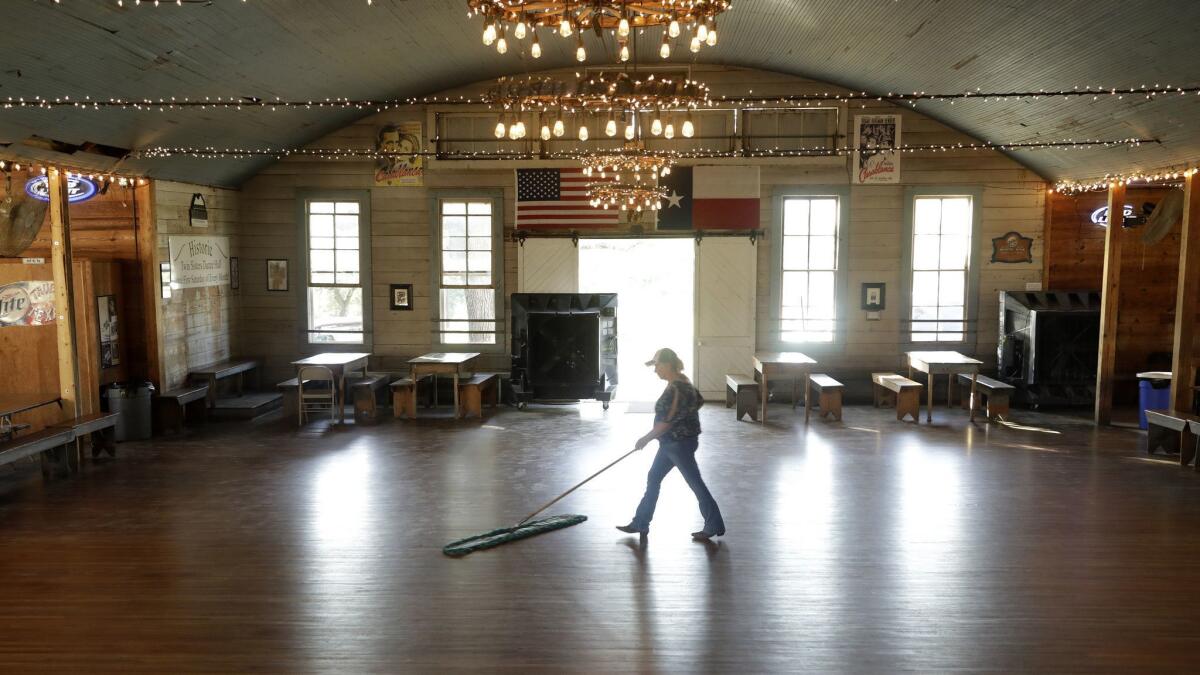
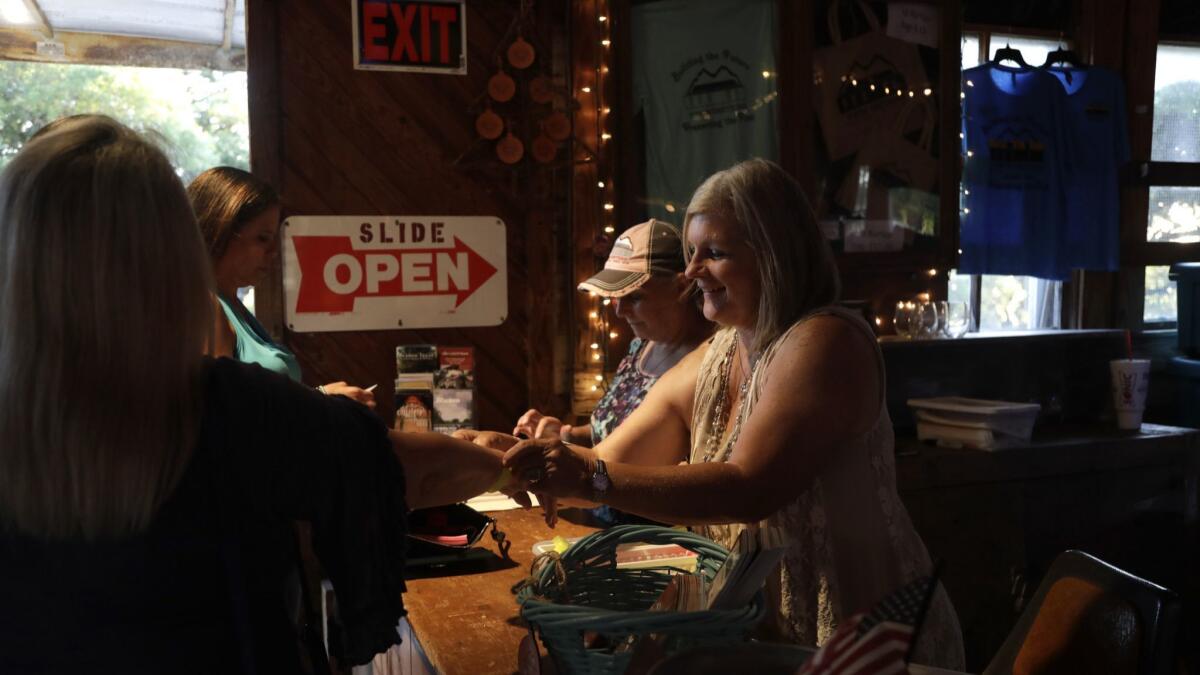

Herring’s father played here with a polka band (clarinet and saxophone), and so did Herring (coronet and trumpet). Kollatschny, whose family was Czech, would drive around before dances to pick up friends in neighboring villages like New Ulm and Sealy, who shouted to their mothers as they left that they were going to the taneční hala, the dance hall.
“That’s the only thing I knew in Czech, other than a few cuss words,” he chuckled.
The dance hall tours also stop at halls being restored by their builders’ descendants. Families have invested tens of thousands in the halls, such as the Reo Palm Isle in East Texas where Elvis played, to Hye Hall near Blanco. It was on the porch of the Hye Hall Post Office that President Lyndon B. Johnson, raised nearby, swore in the new postmaster in 1965.
Jason Cook converted the post office into a restaurant bustling with weekend tourists, and is restoring the pressed-tin-sided dance hall across the street with help from Oliver Deike, whose family ran the place after it was built in 1915.
Deike, who also danced at Twin Sisters, had used Hye Hall for storage, and it fell into such disrepair that he couldn’t insure it. Damp seeped through the 37 plank shutters, the floor warped and the elements faded the sign painted out front: “Next Dance Saturday.”
Now the hall has been cleaned, painted a lush green. The stage has been rebuilt, the floors refinished. The hall’s first event was Saturday: Cook’s wedding reception.
“We’re looking forward to having tastings and dances here, a true community hall,” said his wife, Karen Cook.
To the east in Columbus, Amber Becerra’s family had closed Schneider Hall when the men left to fight World War II, then used it as a hay barn until her younger sister requested they restore it for her wedding in 2010. Becerra’s mother then ran the hall for three years until she was killed in a car accident. Unwilling to see the hall her mother loved close, Becerra quit her job and became the event coordinator. In 2014 she, too, was married at the open-air hall.
Becerra’s ancestors had hosted public dances, allowing guests to park their Model Ts on the lawn, while selling burgers, Dr Pepper and beers like Schlitz and Pearl from an outdoor “soda joint.”
But times have changed. Schneider Hall now hosts graduation parties, baby showers, weddings and quinceaneras. Becerra, who has purple highlights and a penchant for leggings, doesn’t do dances — she worries about security. At a recent wedding, guests ignored her rule against sparklers, and one landed in a 100-year-old live oak, igniting Spanish moss and almost setting the hall on fire.
The hall’s gray cypress walls are more than a landmark to Becerra: They’re living history.
As she set up for a wedding, the air perfumed by a gardenia she planted at the door after her mother died, Becerra pointed to scribbles inside the ticket booth, her great-great-aunt’s penciled calculations.
On another wall, her grandmother had scrawled “Laura loves/likes Joe K.” She died before the hall was restored and Joe’s identity remains a mystery (Becerra’s grandfather’s name was Chester).
She considers it a responsibility to maintain the halls for the next generation, including her 3-year-old daughter, Laurel, named after her grandmother.
“Dancing, like everything else, it will come back around,” she said. “As long as you keep things viable.”
“Dancing, like everything else, it will come back around.”
— Amber Becerra, who runs Schneider Hall
Over at Twin Sisters, Jo Nell Hass is trying to do just that.
The hall’s ceiling, an arched wonder painted robin’s egg blue, is leaking again. She’s hoping to raise money to restore it and to re-create two cypress cupolas that once crowned the hall.
She applied for grants to add story boards outside and to preserve the hall’s “grand drape,” a hand-painted canvas stage curtain featuring a country cottage, surrounded by the names of local businesses.
It’s a rare piece of history, lost at many other halls but preserved here by chance. Twin Sisters is no longer a town, long ago absorbed by neighboring Blanco, but some of the shops on the drape still exist, like Boling Café and Devil’s Back Bone Tavern.
In addition to monthly dances, the hall has recently hosted proms and quinceaneras, hoping to attract a younger crowd. This spring Haas held an under 21 “Hot Texas Swing” dance with lessons that attracted about 30 people from Austin. Now Haas is organizing a September fundraising fiesta, including Native American dancers, a salsa team and mariachi band from Texas State University in San Marcos.
“We’ve tried to embrace as much culture as we can,” she said, “because if we don’t have our youth involved, we’re going to lose these halls.”
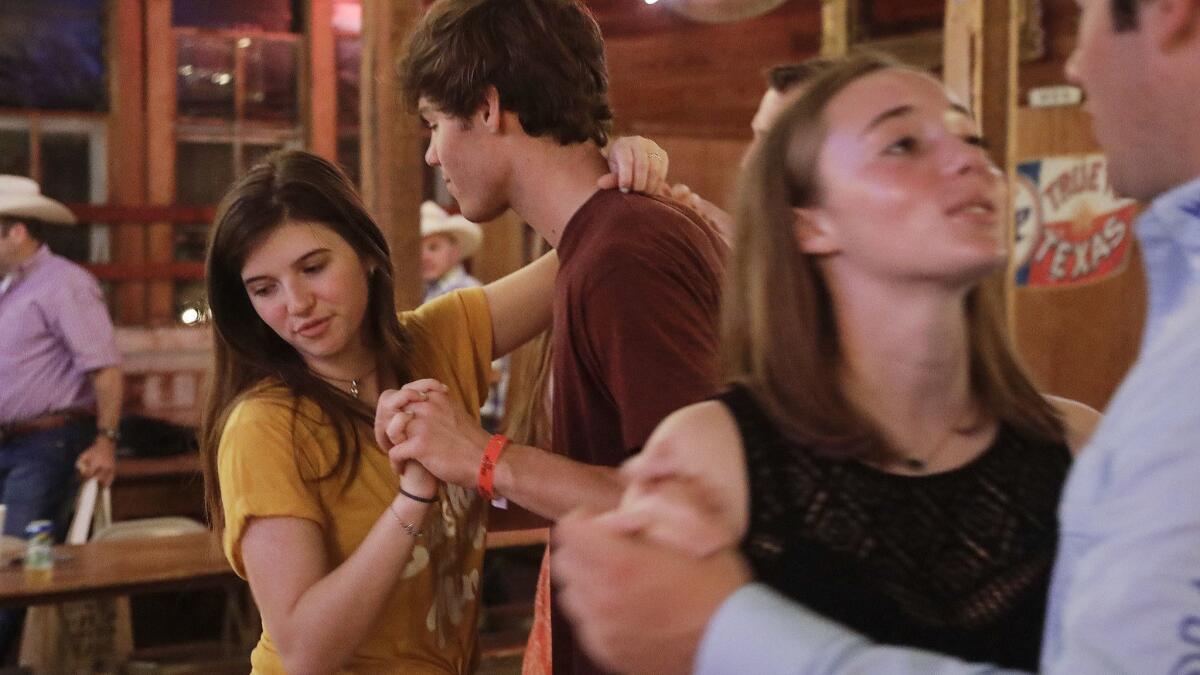

Haas holds dances the first Saturday of every month, with country bands and a food truck. Her husband, Joe, runs the bar, which serves Shiner, Lone Star and other beer, but doesn’t have a liquor license (veteran dancers know to BYOB).
Despite Haas’ worries on a recent Saturday, by night’s end the dance floor had filled with guests of all ages, including youths and a trio of women who took Uber from San Antonio. So many couples swirled across the floor to “Amarillo by Morning” and stomped their way through “Cotton Eyed Joe” that Haas had to sprinkle the planks with wax to keep it smooth.
Michelle Boop brought her entire family: husband, two children, two grandsons and a gaggle of friends, all at her teenage daughter’s urging. They recently moved from elsewhere in central Texas to an old farmhouse up the road, where her husband worked as a ranch manager.
“Just imagine, a hundred years ago people used to come down from the house to dance here,” said Boop, 47, who, like her husband, grew up dancing at other halls.
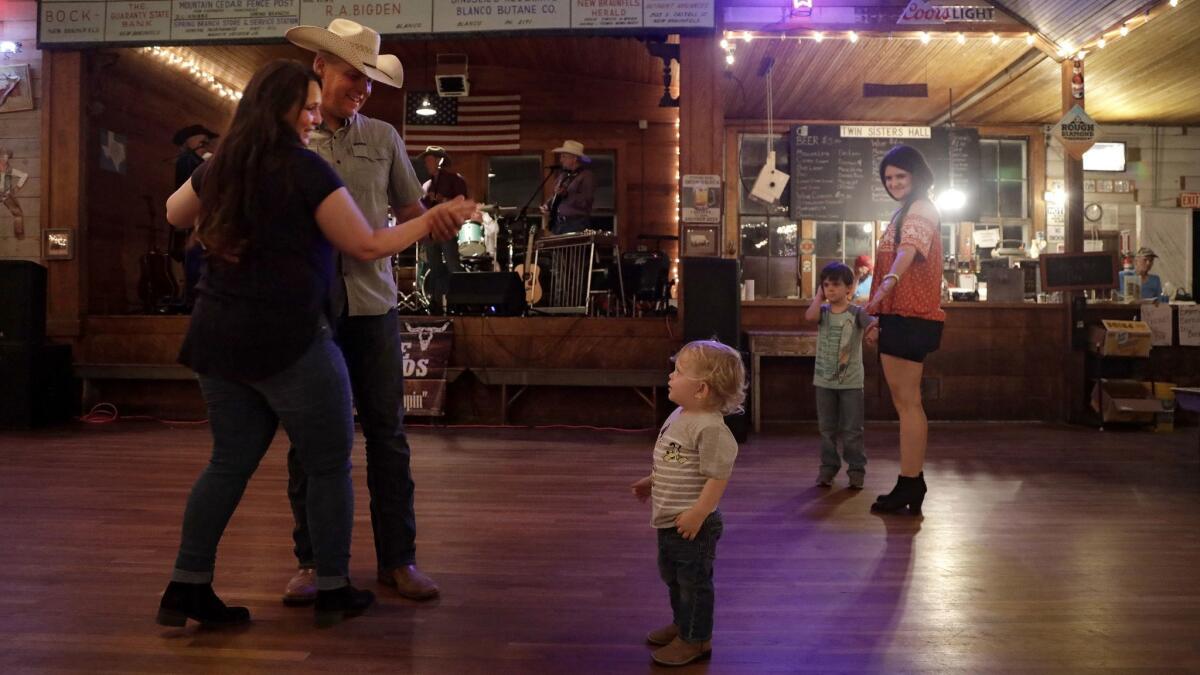
She lingered closer than the buzzard’s nest, keeping an eye on the teenagers, who were forbidden to dance too close or to “inappropriate” songs, such as “Gettin’ You Home.” But she also danced to many songs with her husband, Bill.
Bill Boop, 46, alternately twirled his grandsons and 17-year-old daughter, McKenzie. She squealed in delight, then took to the floor with three classmates, executing a clunky two-step.
After the last song at midnight, “Beer, Bait and Ammo,” the band started to pack up, and Haas tallied her receipts. In total, 80 customers, a decent turnout, especially because some were first-timers like the ladies from San Antonio.
“This hall holds the roots,” she said. “People come back looking for that.”
On July 6, she expects several hundred dancers to come see country singer Gary P. Nunn’s retirement tour. Fans from as far as Dallas were already phoning her about tickets.
Produced by Brian Park
Sign up for Essential California
The most important California stories and recommendations in your inbox every morning.
You may occasionally receive promotional content from the Los Angeles Times.








